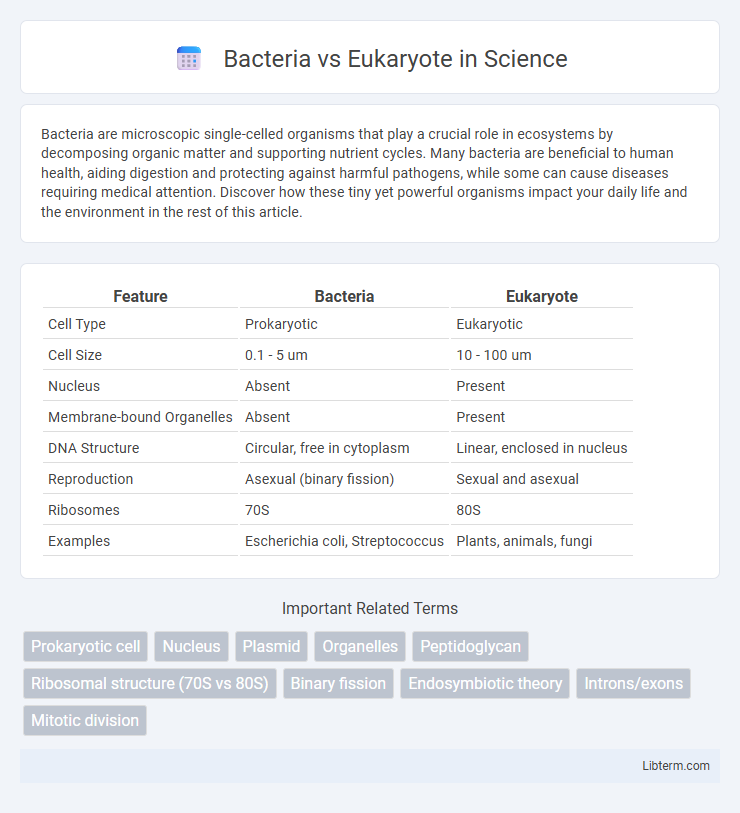Bacteria are microscopic single-celled organisms that play a crucial role in ecosystems by decomposing organic matter and supporting nutrient cycles. Many bacteria are beneficial to human health, aiding digestion and protecting against harmful pathogens, while some can cause diseases requiring medical attention. Discover how these tiny yet powerful organisms impact your daily life and the environment in the rest of this article.
Table of Comparison
| Feature | Bacteria | Eukaryote |
|---|---|---|
| Cell Type | Prokaryotic | Eukaryotic |
| Cell Size | 0.1 - 5 um | 10 - 100 um |
| Nucleus | Absent | Present |
| Membrane-bound Organelles | Absent | Present |
| DNA Structure | Circular, free in cytoplasm | Linear, enclosed in nucleus |
| Reproduction | Asexual (binary fission) | Sexual and asexual |
| Ribosomes | 70S | 80S |
| Examples | Escherichia coli, Streptococcus | Plants, animals, fungi |
Introduction to Bacteria and Eukaryotes
Bacteria are single-celled prokaryotic organisms characterized by the absence of a membrane-bound nucleus and organelles, possessing a simple cell structure with a cell wall composed mainly of peptidoglycan. Eukaryotes exhibit complex cellular organization with a true nucleus enclosed by a nuclear membrane and membrane-bound organelles such as mitochondria and the endoplasmic reticulum. The fundamental differences between bacteria and eukaryotes underline their diverse roles in ecosystems, including bacterial contributions to nutrient cycling and eukaryotic involvement in multicellular organism functions.
Cell Structure Differences
Bacteria are prokaryotic cells characterized by the absence of a membrane-bound nucleus and organelles, possessing a single circular chromosome located in the nucleoid region. Eukaryotic cells have a true nucleus enclosed by a nuclear membrane and contain complex organelles such as mitochondria, endoplasmic reticulum, and Golgi apparatus. Additionally, bacterial cell walls often contain peptidoglycan, whereas eukaryotic cell walls, when present, are composed of cellulose in plants or chitin in fungi.
Genetic Material Organization
Bacteria possess a single circular chromosome located in the nucleoid region, lacking a membrane-bound nucleus, which enables simpler genetic material organization. Eukaryotes have multiple linear chromosomes enclosed within a membrane-bound nucleus, allowing complex regulation of gene expression and chromatin structure. The presence of histones in eukaryotes facilitates DNA packaging, contrasting with the more straightforward bacterial DNA organization.
Methods of Reproduction
Bacteria reproduce primarily through binary fission, a rapid asexual process where a single cell divides into two genetically identical daughter cells, allowing for exponential population growth under favorable conditions. In contrast, eukaryotes utilize a variety of reproductive methods including mitosis for asexual reproduction and meiosis for sexual reproduction, which introduces genetic diversity through the formation of gametes. The complexity of eukaryotic reproduction supports multicellularity and specialization, whereas bacterial reproduction emphasizes speed and adaptability in diverse environments.
Metabolic Diversity
Bacteria exhibit remarkable metabolic diversity, including photoautotrophy, chemoautotrophy, and heterotrophy, enabling survival in various environments from extreme heat to anaerobic conditions. Eukaryotes primarily rely on heterotrophic metabolism with some capable of photosynthesis through organelles like chloroplasts, but their metabolic pathways are generally less varied than those of bacteria. This vast metabolic versatility in bacteria supports biogeochemical cycles, bioremediation, and various industrial applications where eukaryotic metabolism is less adaptable.
Cell Membrane and Cell Wall Features
Bacterial cell membranes are typically composed of a phospholipid bilayer containing hopanoids, which provide membrane stability, while eukaryotic cell membranes lack hopanoids and contain sterols like cholesterol for fluidity regulation. Most bacteria possess a rigid cell wall made of peptidoglycan, offering structural support and shape, whereas eukaryotic cells, such as plant and fungal cells, have cell walls composed of cellulose or chitin, and animal cells generally do not have a cell wall. The interplay between bacterial cell membrane and peptidoglycan wall contributes to antibiotic targeting, distinguishing them functionally from eukaryotic membrane systems.
Size and Complexity Comparison
Bacteria are generally smaller, averaging 1-5 micrometers in size, while eukaryotes range from 10 to 100 micrometers, reflecting significant size differences. Eukaryotic cells exhibit greater complexity, possessing membrane-bound organelles such as the nucleus, mitochondria, and endoplasmic reticulum, which bacteria lack. This structural complexity enables eukaryotes to perform specialized functions and maintain intricate cellular processes not found in simpler bacterial cells.
Evolutionary Origins
Bacteria and eukaryotes diverged from a common ancestor over 2 billion years ago, with bacteria representing some of the earliest life forms on Earth. Eukaryotes evolved through endosymbiotic events, where ancestral prokaryotic cells engulfed other bacteria, leading to organelles like mitochondria and chloroplasts. This evolutionary process highlights the complexity of eukaryotic cells compared to the simpler, single-celled structure of bacteria.
Ecological Roles and Importance
Bacteria play crucial roles in ecological processes such as nitrogen fixation, decomposition, and nutrient cycling, supporting ecosystem productivity and soil fertility. Eukaryotes, including plants, fungi, and animals, contribute to energy flow through photosynthesis, organic matter breakdown, and trophic interactions, maintaining ecosystem stability and biodiversity. Both bacteria and eukaryotes interact symbiotically, driving biogeochemical cycles essential for sustaining life on Earth.
Key Examples and Applications
Bacteria, such as Escherichia coli and Streptomyces, play crucial roles in biotechnology, including antibiotic production and genetic engineering, due to their simple prokaryotic cell structure. Eukaryotes, exemplified by Saccharomyces cerevisiae (yeast) and human cells, are essential for complex bioprocesses like fermentation and medical research involving gene therapy and disease modeling. Understanding the differences between bacteria and eukaryotes enhances applications in agriculture, pharmaceuticals, and environmental management.
Bacteria Infographic

 libterm.com
libterm.com